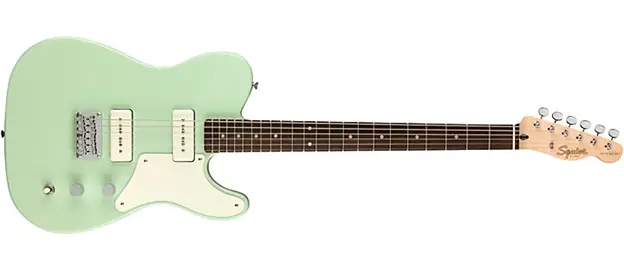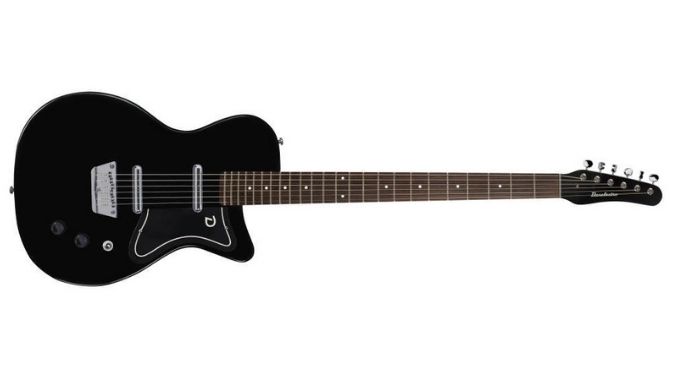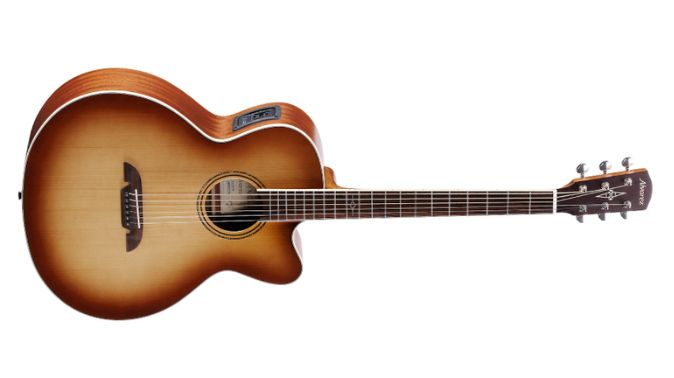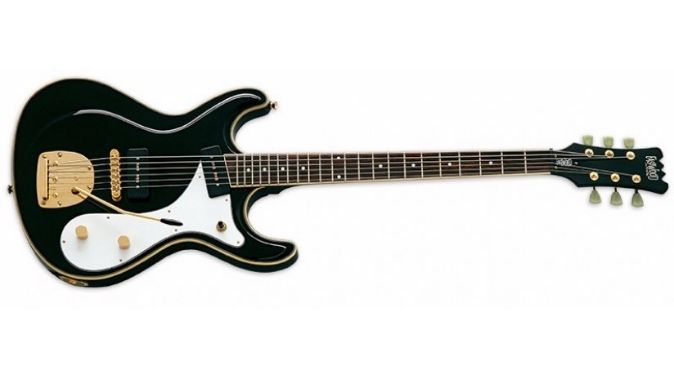I think you’ll agree that it’s hard to find a quality electric baritone guitar for circa $500. There simply aren’t a lot of affordable electric baritones out there that represent solid and versatile options.
Thankfully, the Squier Vintage Modified Baritone Jazzmaster delivers both quality and value. Is the Vintage Modified Jazzmaster the right budget-conscious baritone for you? Read on to find out three reasons Squier’s deep-tuned take on the classic Jazzmaster design might be the best baritone around the $500 mark and the right axe for you.

But first, the Features and Specs
Before we walk through the three reasons you should be interested in the Squier Vintage Modified Baritone Jazzmaster, let’s take a moment to look over the specs of this wallet-friendly baritone.
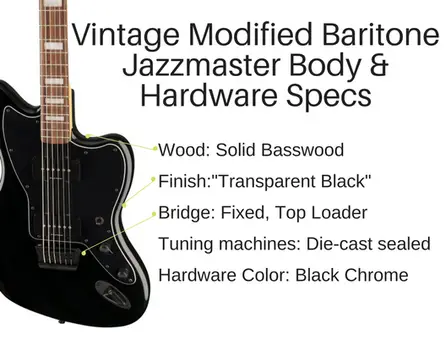
The Baritone Jazzmaster’s body is made of solid basswood, which offers a light but solid feel. Additionally, the black finish and black chrome hardware give this guitar a look that is simple and classy, with a bit of rock and roll attitude.
The Baritone Jazzmaster features a top-loading bridge. Concerning bridges, some purists will assert that Fender’s traditional string-through-body design would offer more sustain. Personally, I appreciate the simplicity of the top load design and believe that any difference in sustain is likely nominal.
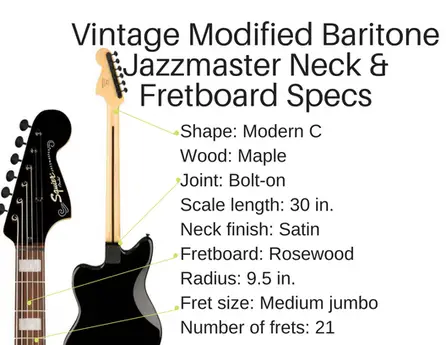
With its 30-inch scale length, the Vintage Baritone Jazzmaster extends nearly 5 inches beyond the bridge to nut length of your typical Stratocaster. Thankfully, the neck’s “modern C” shape and 9.5-inch radius offer a feel that fans of today’s Telecasters and Strats will find familiar. In this way, the Vintage Baritone Jazzmaster offers a comfortable fretting hand experience for most players, despite its extended length.

The Squier Vintage Modified Baritone’s JM (J Mascis) 101 neck and bridge pickups are based on the Dinosaur Junior frontman and lead guitarist’s passion for original issue Jazzmaster pickups. The “Duncan Designed” designation indicates that the pickup’s specs were drawn up by the folks at Seymour Duncan but manufactured by Fender or one of its contractors.
The JM 101 pickups are paired with a stripped-down electronics layout consisting of a three-way selector, a volume nob, and a tone nob. Thankfully, the extra (and largely redundant) switches that adorned the upper bout of the original Jazzmasters have been removed from the Vintage Modified Baritone.
Now that we’ve covered some relevant features, let’s walk through our three reasons the Squier Vintage Modified Baritone Jazzmaster might be the best budget-friendly electric baritone available today.
1. Idyllic Clean Tones
On your clean channel, a circa $500 straight-out-of-Indonesia Squier Vintage Modified Baritone Jazzmaster sounds just like a circa $1,500 American-made guitar. To explore the Baritone Jazzmaster’s clean tone, I ran the guitar through its paces on multiple Fender tube combos and was pleased and surprised at every turn.
With the bridge (AKA, lead) pickup selected, the Baritone Jazzmaster delivers a tone that is bright, responsive, and defined without being shrill and without any of the annoying quacks and pops that plague some budget guitars.
With the neck (aka. rhythm) pickup engaged, the Baritone Jazzmaster delivers bell-like tones without becoming muddy. It’s worth noting that, while warmer in tone, the neck pickup retained some elements of what might be considered a classic Fender sound: a hint of brightness, a balanced response that lets all strings ring clearly, and just a little bit of single-coil edge.
Finally, when it comes to clean tones, the Baritone Jazzmaster puts its best foot forward with both pickups engaged. The resulting tone is full, balanced, and incredibly pleasing to the ears. I found myself wanting to use this lush tone on stage and in the studio. Indeed, this baritone’s dual pickup setting offered a clean sound that could fit the bill for both lead and rhythm work.
Check out the video below to get a feel for the Squier Vintage Modified Baritone’s tonal offerings. The clip begins by showcasing the guitar’s clean tones and finishes with a brief sampling of overdrive tones. And, speaking of overdrive tones, our second reason to get your hands on this baritone is all about the guitar’s potential as a high-gain machine.
2. Great Distorted Tones (With Just One Catch!)
To get a feel for the Squier Vintage Modified Baritone Jazzmaster’s distorted tonal offerings, I first ran the guitar through a Fender tube combo with a hint of overdrive and then through a few higher gain tube amps.
With just a hint of overdrive, the Baritone Jazzmaster sounds great. With the neck pickup engaged, I was able to dial in a great baritone blues tone (imagine a beefed-up and rounded-out version of John Lee Hooker’s classic tone). Switching to the bridge pickup, the same hint-o-overdrive setting conjured up a deep version of Mark Knopfler’s “Sultans of Swing” tone.
At higher gain levels, the Baritone Jazzmaster excelled with the neck pickup selected and with both pickups engaged. With the neck pickup on and the gain up, the Baritone Jazzmaster cranked out a Stevie Ray Vaughan-like tone. With both the neck and bridge positions engaged, the JM 100 pickups had plenty of color and a smooth and defined tone that invited baritone renditions of Van Halen classics.
The one catch with the Baritone Jazzmaster’s high gain tone shows up when you switch the three-way selector to the bridge or lead pickup. The resulting tone had a little too much high-end edge for my taste. I tried a few EQ settings and found that a “scooped mid” setting (dropping the amp’s mid-EQ way down while leaving the bass at 5 and the treble around 4) best resolved this issue.
Even with that one cautionary note, the Baritone Jazzmaster still represents one of the best tone-for-dollar values among baritone electrics. With its generous pallet of useful tones, ranging from blissful cleans to rich distorted settings, it’s hard to imagine this guitar not adding value to your arsenal of sonic weapons.
3. The Baritone Jazzmaster Lets You Get LOW With No Fret Buzz
As a baritone enthusiast, I have gotten in the habit of tuning my baritones to B standard tuning (aka. tuning down a perfect fourth). I like to strum, pick out lead lines, and play with abandon – things you typically cannot do in the other common baritone tuning: A standard tuning (aka. tuning down a perfect 5th). Typically, playing with any intensity will result in some fret buzz on an A standard-tuned baritone. For more on baritone tuning, check out our guide, Baritone Guitar Tunings – A Complete Guide to Traditional & Alternative Tunings.

The Squier Vintage Modified Baritone Jazzmaster is the exception to this rule. I put the axe through its paces from Jazz vamping to 80’s shred, all while in A-standard tuning. The result? The Vintage Modified Baritone handled A-standard (down a perfect 5th) tuning better than any other electric baritone I have ever played.
The Vintage Modified Baritone’s exceptional down-tuned performance is the result of two factors: quality of build and string action.
The quality of build on the Vintage Modified Baritone’s neck was surprising. My demo guitar featured smooth and well-finished frets without any bumps or errant glue work. The neck and fingerboard were also without any obvious design flaws. Both looked and felt great. When a neck is built right and finished well, you greatly reduce the chance of having fret buzz issues and you expand the guitar’s ability to handle different tunings.
Concerning the string action, the Squire Vintage Modified Baritone features a higher-than-average distance between the fretboard and strings. It seems as though the folks at Fender are taking some design cues from J Mascis, as the rock guitarist is known for setting up his own Jazzmaster with a somewhat high action.
For the most part, the Vintage Modified Baritone’s action did not throw me off. The distance between fret and string only became an issue for me while trying to play the solo from Ozzy Osbourne’s Crazy Train. That being said, guitarists who are new to the baritone world might find that the upper register of the Vintage Modified Baritone’s neck produces some challenges, especially during the first few weeks of owning the guitar.
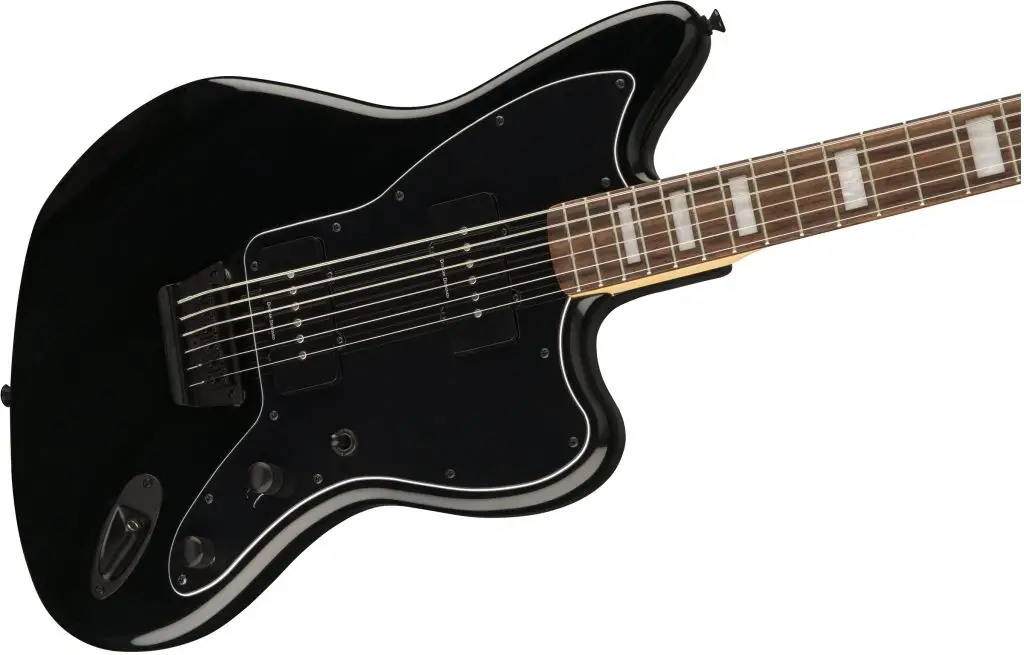
Conclusion
At around $500, it’s hard to beat the Squier Vintage Modified Baritone Jazzmaster. This no-nonsense baritone truly makes a great case for being the best baritone in its price range. You should consider the Baritone Jazzmaster if you are…
- A guitarist who plays multiple styles and needs a tonally versatile instrument.
- On a budget, but might end up using a baritone on stage or in the studio.
- New to baritone guitar, but willing to put up with a period of adjusting to the Baritone Jazzmaster’s higher-than-average action.
- A fan of tuning your baritone to A-standard tuning (aka. perfect 5th) or if you enjoy using alternative tunings.
Of course, you could save $50 and go with a Danelectro 56, but you might end up sacrificing more than fifty bucks in tone and versatility. You could also keep your eye on Guitar Center’s used guitar listings to try and score a pre-owned baritone.
If you can stretch your budget closer to $700 or $1000 bucks, the Ibanez RGIB6 and the Reverend HC represent great upscale options. That being said, even if you have a custom shop budget, you should still consider the Squier Vintage Modified Baritone Jazzmaster. Its mix of exceptional tone and amazing value make it a solid option for any baritone player.
Thanks for taking the time to read this article, we hope you found it valuable. And be sure to check our other electric baritone reviews!

